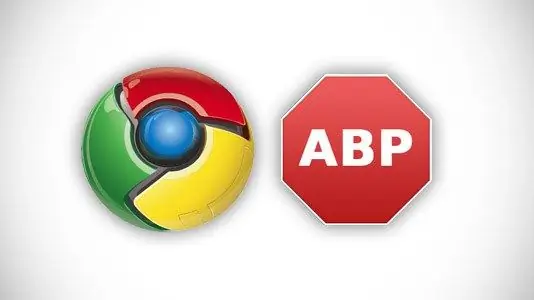- Author Lauren Nevill [email protected].
- Public 2023-12-16 18:48.
- Last modified 2025-01-23 15:15.
Despite the fact that advertising has become a familiar attribute of modern life, sometimes it becomes too much and it becomes difficult to make out everything else behind bright colors and obsessive flickering. Do not tolerate this, because to get rid of ads in the browser, you just need to tweak your computer a little.

Instructions
Step 1
The easiest way to remove ads in your browser is to install a plugin. There are also other names: extension, addition, extension - the essence is the same, this is a small program, in fact a module that increases the functionality of a larger program. To block ads, you need the Adblock plugin. There are also analogues, usually with the word adblock and a small postscript. Their functionality is similar, but it is recommended to use options with a high rating and a large number of downloads. To install the extension, you first need to open the app store for your browser.
In the Chrome browser, you need to click on the symbol of three dots in the upper right corner of the program, select the menu item "Additional tools", and in it "Extensions". In the window that opens, scroll down the already installed add-ons to the end of the page, and click on "More extensions". In the window that opens, you need to find the search bar and type adblock there. A list of available extensions will open, where you can select the desired option and click on the "Free" button.
For the Opera browser, you need to click on the Opera sign in the upper left corner of the program, and select "Extensions" there. Enter the name of the plug-in into the search, and then click opposite the desired "Add to Opera".
In the Firefox browser, you need to click on the button with three horizontal lines in the upper right corner of the program. There, select the "Add-ons" menu item, then "Extensions", select the plug-in and click "Install".
After installation, you will hardly see ads, except in some cases. After all, site owners are well aware of ad blockers, and if you really want to, adblock can be bypassed. But this practice is not very common.

Step 2
Ads may appear due to third-party malware. It can be installed bundled with other programs downloaded from unverified sources, it can come from infected flash drives or malicious sites. This type of virus (malware) is not always recognized by antivirus, so even a good paid product will not give a 100% guarantee of protection.
There are special programs for cleaning malware adware. One good example is Malwarebytes. You can find it through the search, but it is recommended to download it only from the official website. There is a free version. After installation, start the scan with the "Scan now" button and wait for the results of the work. After completion, click on "Apply changes", thereby sending the found malware to quarantine. The program will remove all known rogue programs from your computer, but it may miss something. After all, burglars do not sit still and come up with something new all the time.
Step 3
If automatic removal tools do not help, manual malware removal comes into play. The first step is to enable the display of system files in the operating system. The fact is that the system protects important files from accidental deletion or damage by hiding them when viewed by Explorer. And viruses and malware use the same mechanism, hiding from the user's eyes.
First you need to press the special key combination Win + R. Win is a special button on the keyboard with the image of the Windows flag, it is located in the bottom row of the keyboard between the left ctrl and alt. After entering the special command, the "Run" window will open. In it you need to type control folders and click OK. In the window that opens, go to the "View" tab and perform two actions. The first is to uncheck the box "hide protected system files", the second is to check the box "show hidden files, folders and drives". Next, you need to save the changes with the OK button, and press the second special key combination: ctrl + alt + Esc. The Task Manager window opens and requires the first Processes tab. This tab displays active processes in the system, including malicious ones, if any. You need to search for the following names:
- Awesomehp;
- Babylon;
- CodecDefault;
- Conduit eDeals;
- DownloadHelper;
- iWebar;
- Mobogenie;
- MiPony;
- Pirrit Suggesto;
- Podoweb;
- Search Protect;
- Sense;
- ShopperPro;
- Webalta;
- Websocial;
- YouTube Accelerator.
If there are matches, then on the found process, you need to right-click and select the "Open file location" menu item. An explorer window will open with the malware folder. Next, you need to right-click to stop the process in the Task Manager, and then delete the folder of the malicious program along with the files. You should be careful and look in which folder the malware was found. If it is a separate folder with 3-4 files with an arbitrary name, then the entire folder can be deleted. If the malware sits in the system32 folder, then deleting the entire folder will delete the system files of the operating system. The step is important and responsible, and in case of any doubts it is better to play it safe and not to remove it in the heat of the moment.
Step 4
The next thing to do is check the browser shortcut. Right-click on the shortcut of your browser on the desktop or on the quick launch bar, and select the "Properties" menu item. In the window that opens, you need to check the entry field for the "Object" item. There should not be any links after the path of the file with the.exe extension at the end. If they are, then the links must be removed and click OK.
Step 5
You also need to check the start page of the browser. To do this, you need to launch the browser and open its settings. In Chrome, this will be "Settings", then "Start Group", in Opera, it will be "Settings" and then "At Startup". In Firefox "Settings", then "General", then "Start". If suspicious unfamiliar entries are found, they should be deleted.
Step 6
If there are malicious entries in the browser, then the problem may be in the extensions. You need to open the list of extensions, as already described in the first paragraph, and look for suspicious entries. In which case, they can be temporarily disabled and the result checked, and then removed if necessary.

Step 7
The last point will be to check the hosts file. First you need to click "Start" and type notepad. Notepad will appear in the search results and you need to right-click on it by selecting "Run as administrator". Next, you need to open the "File" menu item, in it "Open" and in the "File name" input window you need to insert C: / Windows / System32 / drivers / etc and click Open. The required directory will open, in which you should select the hosts file. If it is not visible, then select All files instead of *.txt above the Open button in the selection field. In the hosts file, you need to look at the lines below line 127.0.0.1, and if you yourself did not add anything there, the excess should be deleted and rebooted.






